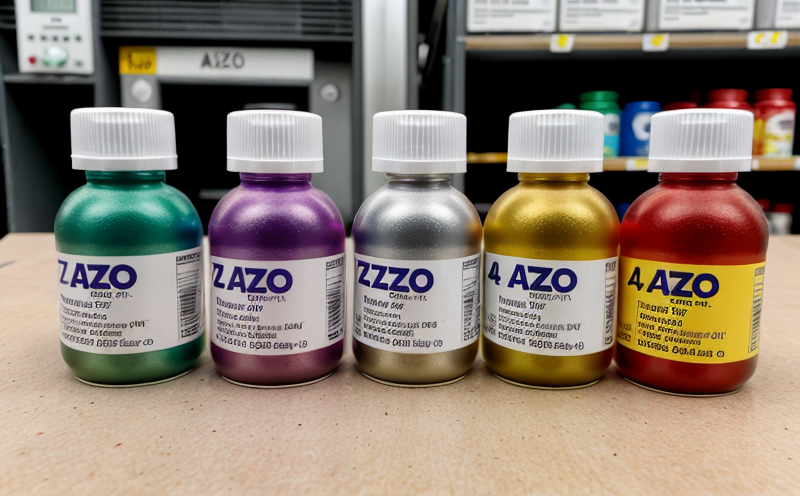Heavy Metals & Azo Dyes Testing
In today’s regulatory landscape, ensuring compliance with environmental and health standards is paramount. Heavy metals and azo dyes testing play a critical role in safeguarding the quality of textiles that come into contact with human skin or are exposed to natural environments. This service encompasses a range of tests designed to identify harmful substances like lead, cadmium, chromium, and azo compounds which can be detrimental if present at unacceptable levels.
The importance of this testing cannot be overstated, especially for industries such as fashion, home textiles, and personal care products where consumer safety is a top priority. Regulatory bodies around the world have implemented stringent guidelines to control the use of these substances in textile manufacturing processes. Compliance with these standards not only ensures product quality but also protects brands from potential recalls or legal actions.
Our laboratory utilizes advanced analytical techniques including Inductively Coupled Plasma Mass Spectrometry (ICP-MS) for heavy metals analysis and High Performance Liquid Chromatography coupled with Tandem Mass Spectrometry (HPLC/MS/MS) for azo dye detection. These methods provide accurate results that adhere to international standards such as ISO, ASTM, EN, and Oeko-Tex.
The testing process involves several key steps starting from sample preparation where textiles are cut into appropriate sizes ensuring uniformity across all samples being tested. Each sample is then subjected to rigorous analysis using state-of-the-art equipment. The results are meticulously recorded and compared against established thresholds set by relevant regulatory bodies. Compliance reports are generated promptly after thorough evaluation allowing clients immediate access to their product’s compliance status.
By opting for heavy metals & azo dyes testing, businesses can demonstrate their commitment to ethical manufacturing practices while maintaining high standards of quality assurance. This service is particularly beneficial for companies aiming to expand into international markets where stringent regulations regarding textile safety exist.
Why It Matters
The presence of heavy metals and azo dyes in textiles can lead to significant health risks if not properly managed. Heavy metals such as lead, mercury, cadmium, arsenic, and nickel are toxic elements that can cause various adverse effects on human health when absorbed through the skin or ingested during wear. These include but are not limited to respiratory issues, kidney damage, neurological disorders, reproductive problems, and even cancer.
- Health Risks: Exposure to high levels of heavy metals can result in severe health complications ranging from mild irritation to chronic diseases like Parkinson’s disease or Alzheimer's.
- Safety Concerns: Azo dyes have been linked to allergies and carcinogenic properties. Certain azo compounds may break down into aromatic amines upon washing, posing potential hazards during the dyeing process or subsequent use of the textiles.
Beyond individual health concerns, non-compliance with regulations can lead to severe repercussions for businesses including fines, reputational damage, and loss of market share. Many consumers today are increasingly aware and concerned about what goes into their clothes; hence, demonstrating adherence to rigorous testing protocols can significantly enhance brand reputation.
Applied Standards
| Standard Code | Description |
|---|---|
| ISO 14362-1:2005 | Determination of azo compounds - Part 1: Identification and quantification in textile materials by high-performance liquid chromatography with tandem mass spectrometry (HPLC/MS/MS) |
| ISO 17894-3:2015 | Determination of heavy metals - Part 3: Determination of chromium, copper, nickel, zinc, cadmium, lead and mercury in textile materials by inductively coupled plasma mass spectrometry (ICP-MS) |
| EN 12358-1:2014 | Determination of azo compounds - Part 1: Identification and quantification in textile products by high-performance liquid chromatography with tandem mass spectrometry (HPLC/MS/MS) |
| EN ISO 17896-2:2015 | Determination of heavy metals - Part 2: Determination of arsenic, boron, cadmium, chromium, copper, nickel, selenium, silver, tin and zinc in textile materials by inductively coupled plasma mass spectrometry (ICP-MS) |
| ASTM D5869-17 | Standard Guide for Selection of Acceptance Sampling Plans for Textile Products |
The above standards provide comprehensive guidelines on how to conduct accurate and reliable tests for identifying heavy metals and azo dyes in textile products. Adherence to these standards ensures consistency, accuracy, and reliability in testing results.
Customer Impact and Satisfaction
- Enhanced Reputation: Providing assurance that your products meet international safety standards can significantly enhance your brand’s reputation among consumers who value ethical manufacturing practices.
- Increased Sales: Compliance with regulations opens up new markets where stringent testing requirements are enforced. Meeting these standards increases the likelihood of successfully entering or expanding into such markets.
- Reduced Risk: By proactively identifying and addressing potential issues early in the production process, you can minimize risks associated with non-compliance which could lead to costly recalls or legal disputes.
- Improved Product Quality: Rigorous testing helps ensure that your final products are free from harmful substances, thus improving overall product quality and reliability.
- Prompt Reporting: Our service offers quick turnaround times for test results which allows you to make informed decisions promptly regarding any necessary corrective actions.
The satisfaction of our customers is paramount in everything we do. We strive to meet their needs by providing accurate, reliable tests conducted under strict adherence to relevant international standards ensuring peace of mind knowing that your products are safe and compliant.





